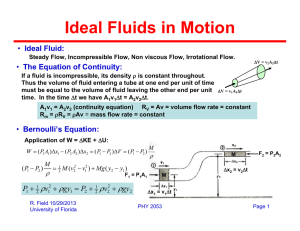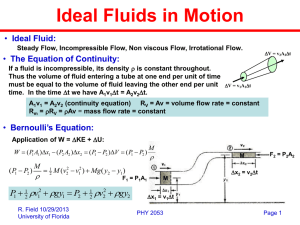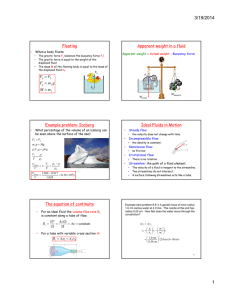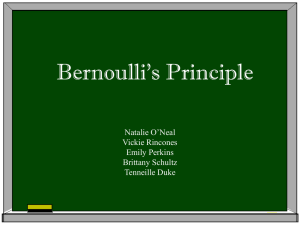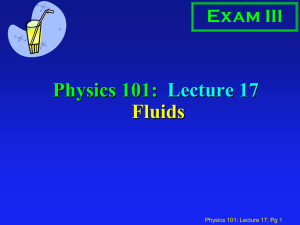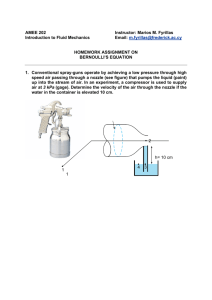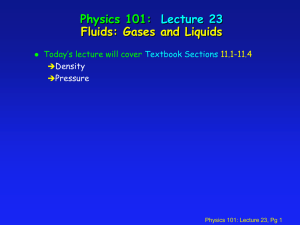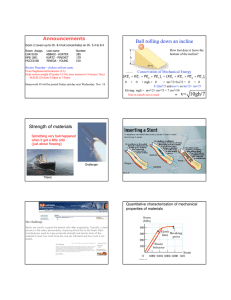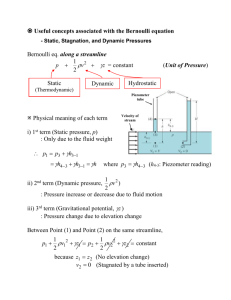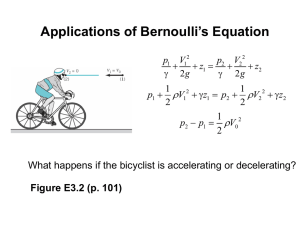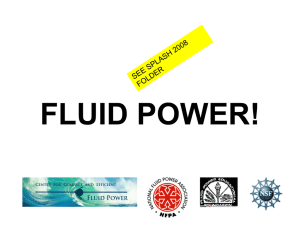fluid flow 1rb solutions
advertisement
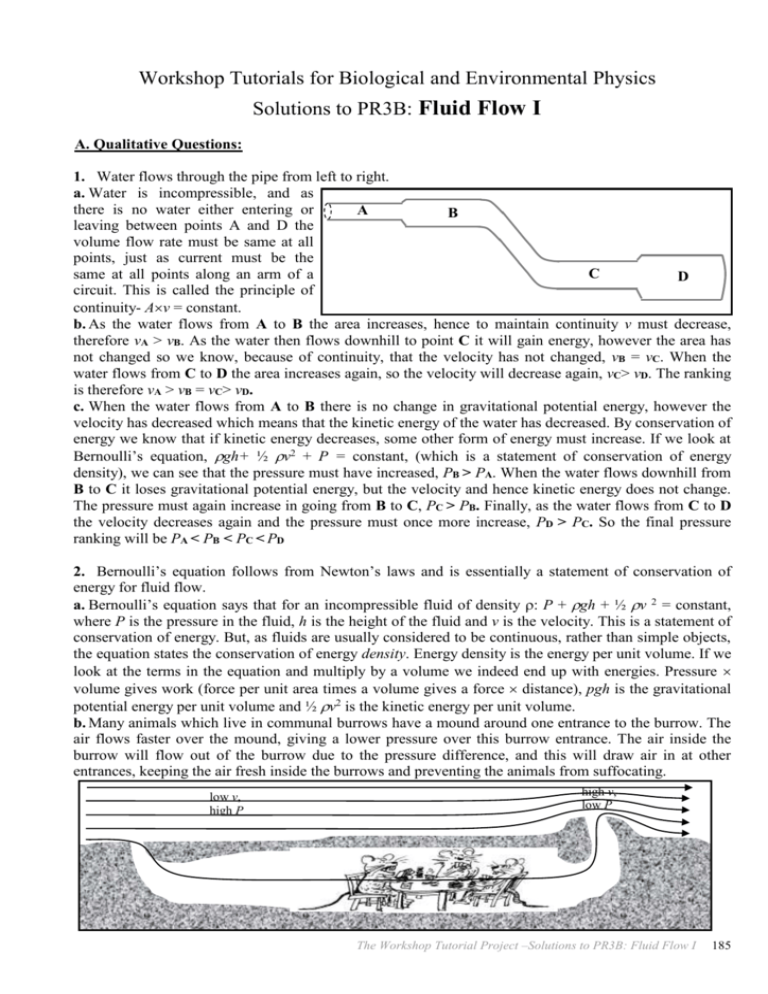
Workshop Tutorials for Biological and Environmental Physics Solutions to PR3B: Fluid Flow I A. Qualitative Questions: 1. Water flows through the pipe from left to right. a. Water is incompressible, and as there is no water either entering or A B leaving between points A and D the volume flow rate must be same at all points, just as current must be the C same at all points along an arm of a D circuit. This is called the principle of continuity- Av = constant. b. As the water flows from A to B the area increases, hence to maintain continuity v must decrease, therefore vA > vB. As the water then flows downhill to point C it will gain energy, however the area has not changed so we know, because of continuity, that the velocity has not changed, vB = vC. When the water flows from C to D the area increases again, so the velocity will decrease again, vC> vD. The ranking is therefore vA > vB = vC> vD. c. When the water flows from A to B there is no change in gravitational potential energy, however the velocity has decreased which means that the kinetic energy of the water has decreased. By conservation of energy we know that if kinetic energy decreases, some other form of energy must increase. If we look at Bernoulli’s equation, gh+ ½ v2 + P = constant, (which is a statement of conservation of energy density), we can see that the pressure must have increased, PB > PA. When the water flows downhill from B to C it loses gravitational potential energy, but the velocity and hence kinetic energy does not change. The pressure must again increase in going from B to C, PC > PB. Finally, as the water flows from C to D the velocity decreases again and the pressure must once more increase, PD > PC. So the final pressure ranking will be PA < PB < PC < PD 2. Bernoulli’s equation follows from Newton’s laws and is essentially a statement of conservation of energy for fluid flow. a. Bernoulli’s equation says that for an incompressible fluid of density : P + gh + ½ v 2 = constant, where P is the pressure in the fluid, h is the height of the fluid and v is the velocity. This is a statement of conservation of energy. But, as fluids are usually considered to be continuous, rather than simple objects, the equation states the conservation of energy density. Energy density is the energy per unit volume. If we look at the terms in the equation and multiply by a volume we indeed end up with energies. Pressure volume gives work (force per unit area times a volume gives a force distance), pgh is the gravitational potential energy per unit volume and ½ v2 is the kinetic energy per unit volume. b. Many animals which live in communal burrows have a mound around one entrance to the burrow. The air flows faster over the mound, giving a lower pressure over this burrow entrance. The air inside the burrow will flow out of the burrow due to the pressure difference, and this will draw air in at other entrances, keeping the air fresh inside the burrows and preventing the animals from suffocating. low v, high P high v, low P The Workshop Tutorial Project –Solutions to PR3B: Fluid Flow I 185 B. Activity Questions: All the activity questions can be explained in terms of Bernoulli’s Principle. For a simple model in which air is moving horizontally, P + ½ v2 = constant. Thus if speed of flow increases then the pressure must decrease. A pressure difference produces a force F = P.A directed from the region of high pressure to the region of low pressure. 1. Ball in an air jet The air jet has a velocity profile with the air in the middle having greater velocities than the air near the edges. So if the ball is balanced in the air jet as shown, v1 > v2 and P1< P2. This pressure difference results in a 'lift' force up which is equal and opposite to the weight of the ball. v 1, P 1 v2, P2 air flow . 2. Chimney effect The air rushing past the top of the chimney has lower pressure than the air in the chimney. There is a net upward force on the air and foam balls in the chimney, and the air and the balls rise. This effect is also used by burrowing animals to ventilate their burrows P < Patm Patm smoke 3. Blowing and lifting As air rushes through the narrow gap it speeds up and the pressure drops. There is atmospheric pressure under the polystyrene so the pressure difference results in a force up, equal and opposite to the weight of the polystyrene. air flow P < Patm Patm 4. Two sheets of paper There is reduced pressure between the sheets of paper and they move inwards. Other examples are passing vehicles, lower end of a shower curtain curling towards the water. Patm P < Patm v Patm C. Quantitative Questions: 1. Smoking causes inflammation of the bronchioles, the small air passages in the lungs, which tends to decrease the flow of air into the lungs and hence the oxygen supply to the blood. Air is flowing down a normal section of a bronchiole with a diameter of 1 mm at a velocity of 0.5 m.s-1. a. Part of the bronchiole is narrowed due to inflammation, and has a diameter of only 0.7 mm. We can use continuity to find the flow rate in this region: A1v1 = A2v2. v2 = A1v1 / A2 = r1 2 v1 / r2 2 = (½ 1.0 10-3 m) 2 0.5 m.s-1 / (½ 0.7 10-3 m) 2 = 1.0 m.s-1. b. If the air moves past the surfaces much faster then the oxygen spends less time in contact with the gas exchange surfaces and is less likely to be absorbed, decreasing the oxygen supply to the body. To compensate for this the lungs and heart have to work harder to get more oxygen and move it around more effectively. 2. We can use Bernoulli’s equation to solve this, taking the top of the tank as one point A in the flow, and the gauge as point B. We can call the height at B hB = 0, then the height at A is hA = 1.0m. We have: PA + ghA + ½ vA 2 = PB + ghB + ½ vB 2, and the pressure at B is now: PB = PA + ghA + ½ (vA 2 – vB 2) = 100 kPa + 1 103 kg.m-3 9.8 m.s-2 1.0 m + 1 103 kg.m-3((0.01 m.s-1)2 – 0.5 m.s-1)2) = 100 kPa + 9.8 kPa – 0.25 kPa = 110 kPa. 186 The Workshop Tutorial Project –Solutions to PR3B: Fluid Flow I.
